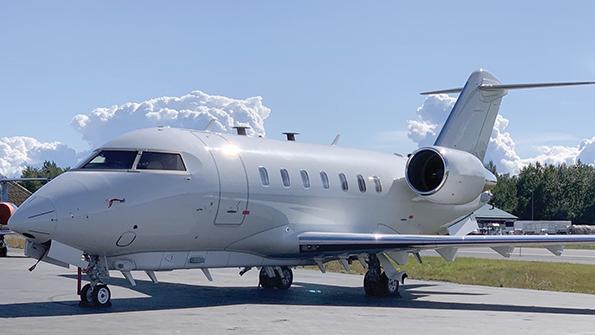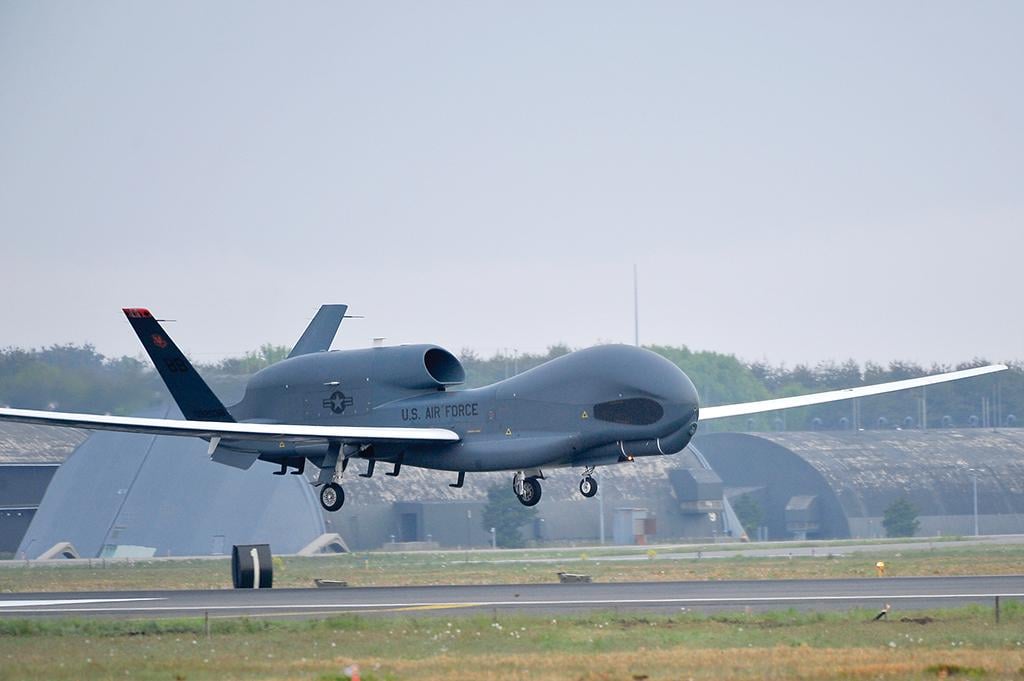
A U.S. Army RQ-4D Global Hawk flying at 65,000 ft. detects a communication signal from an enemy’s corps-level headquarters. The Global Hawk’s processor uses a geolocation technique to cue the onboard signals intelligence (sigint) receiver, and synthetic aperture radar payloads verify the target and location. The targeting data is then relayed over the horizon to an Army Precision Strike Missile battery, which fires a round hundreds of kilometers downrange.
It may seem incongruous to envision an Army-owned, high-altitude, unmanned aircraft system (UAS) flying at heights now reserved solely for the U.S. Air Force’s intelligence, surveillance and reconnaissance (ISR) fleet.
And it may feel unnatural for that Army-owned UAS to provide over-the-horizon targeting to an artillery system that is capable of reaching targets at distances now reserved only for the Air Force’s stealthy bomber fleet.
- High-altitude UAS are part of the Army’s long-term plan
- Analysis of alternatives IS nearing for HADES payload
But the Army Futures Command has defined an ambitious long-term vision that severs the traditional reliance on the Air Force’s ISR and striking power to address threats to the ground-maneuvering forces. The Army’s concept for a Multi-Domain Sensor System (MDSS) seeks to build a new organic capability to find and strike targets far beyond the range limit of 186 mi. of the current Advanced Tactical Missile System.
That vision could include a new version of the RQ-4, even as the Air Force seeks authority from Congress this year to divest two-thirds of its own Global Hawk fleet.
“Northrop Grumman is looking into a Global Hawk that will fly higher than around 60,000 ft., which it’s flying at right now, and give us more range,” Ted Girouard, the Army’s deputy capability manager for sensors, said at an Association for Unmanned Vehicle Systems International conference in September.
The Army’s Program Executive Office for Intelligence, Electronic Warfare and Sensors (IEW&S) has started the acquisition process for the service’s first operational high-altitude ISR capability.
The IEW&S office staff is preparing to launch an analysis of alternatives study for the MDSS, which will shape the acquisition strategy for the future airborne ISR program.
By definition, the strategy is not set until the analysis is complete, but Girouard, who has five decades of Army experience, already has a feeling for how it will work out.

A higher-altitude version of the Global Hawk or similar high-altitude, long-endurance (HALE) UAS would need to be developed by Northrop or other contractors, but several other options exist at lower altitudes. These include derivatives of commercial airliners and business jets already in service with the Air Force and the Navy, including the Boeing 737-derived P-8A, Bombardier Global 6000-derived E-11 and Gulfstream G550-derived C-37.
“Given the state of the technology and [the availability] of a business jet-based platform, that might be the first platform we go to” for MDSS, Girouard says.
A fleet of fewer than 10 business jet derivatives would be viewed as an interim bridge to the full MDSS in 2035. In both cases, the goal is to improve dramatically the altitude and sensor capability of the Army’s current fleet, which is limited to the 35,000-ft. service ceiling of the RC-12X Guardrail Common Sensor.
“We’re looking for a platform that can give us more altitude, so that we get what the engineers call the geometry to be able to look farther and find targets,” Girouard says.
The Army’s new dedication to high-altitude ISR and long-range strike has not gone unnoticed inside the blue-hued corridors of the Pentagon. Gen. David Goldfein, the Air Force’s recently retired chief of staff, refused repeatedly to engage in any criticism of the Army’s investment strategy when pressed by journalists during his tenure. His replacement, Gen. Charles Brown, Jr., however, appears more willing to raise the Air Force’s objections in public.
“We do need to have a conversation about how we ensure, with the limited dollars we’re going to have, [that we] look at the disparate mission sets,” Brown says. “It’s worth a dialog. We’ve got to talk about this.”
But as the Defense Department prepares the fiscal 2022 budget request for release in February, the Army does not appear to be backing down. Building an organic long-range strike capability within the Army is seen as central to the Multi-Domain Operations concept, and the Long-Range Precision Fires program is the top modernization priority. The Army also does not view overlapping investments in long-range strike as necessarily a bad thing.
“I’m convinced that across the joint force, we all recognize that there’s enough targets out there for all of us,” Col. John Rafferty, the Long-Range Precision Fires program manager, said in August. “And we’re going to have to figure out how to sort this out.”
As the high-level discussions begin in the Pentagon, the Army’s airborne intelligence branch is rapidly getting up to speed on high-altitude ISR collection. Fifteen years have passed since the Army canceled the Embraer ERJ-145-derived Aerial Common Sensor program. During the interim, the service was mostly focused on the counterinsurgency and counterterrorism mission; new versions of the RC-12 and a modernized version of the ARL-7 Airborne Reconnaissance Low were deemed sufficient.
By 2016, the Army started to pivot to more sophisticated threats. Its striking power had been limited to the Army Tactical Missile System, with a maximum range set 124 mi. short of the 310-mi. threshold for the 1987 Intermediate-Range Nuclear Forces (INF) Treaty. As soon as the INF Treaty expired in August 2019, however, the Army was prepared to lift the maximum range of the Precision Strike Missile (PRSM) beyond 310 mi. Raytheon’s withdrawal from the PRSM competition in April left Lockheed as the only remaining supplier. The Army expects to field the PRSM battery in fiscal 2023.
A long-range missile requires high-altitude targeting support. In previous decades, the Army had relied on the Air Force’s satellites and ISR aircraft, such as the radar-equipped E-8C Joint Stars and sigint-oriented RC-135 Rivet Joints. The Air Force plans to replace the battle management and command-and-control functions of the E-8C in 2025 with the Advanced Battle Management System but has identified no direct replacement for the Joint Stars’ APY-7 synthetic aperture radar (SAR) with a ground-moving-target-indicator (GMTI) mode.
The Army decided to take matters into its own hands. Gen. John Murray, the head of Army Futures Command, signed an initial capabilities document in February 2019 for a new airborne ISR-collection payload. The High-Accuracy Detection and Exploitation System (HADES) seeks to combine the functions of an E-8C and an RC-135 onto the same platform, with sigint and SAR/GMTI sensors aboard. Murray signed the capability decision document on Aug. 17 for HADES, Girouard says. The latter approval allows the IEW&S program executive office to begin preparing for the analysis of alternatives.
The Air Force chose not to replace the E-8C for a reason: Looming threats after 2025 would render radiating ISR aircraft such as Joint Stars too vulnerable to perform the mission, according to Air Force officials. Despite that warning, the Army does not seem deterred by the Air Force’s perspective on the near-term threat. For that matter, the Army’s opinion seems endorsed by the Navy, which has continued investing in the P-8A and Northrop MQ-4C Triton, the maritime version of the Air Force’s Global Hawk.
The study will benefit from flight-test data collected by a testbed aircraft deployed to Okinawa in July. The Airborne Reconnaissance and Targeting Multi-Mission Intelligence System (Artemis) is a Leidos-owned Bombardier Challenger 650 business jet equipped with commercial off-the-shelf sensors. The Challenger 650 has a 41,000-ft. service ceiling, giving the Army a sneak peek into the advantages of ISR collection at higher altitudes. The Artemis aircraft redeployed to Europe from Okinawa in September.
Meanwhile, Army officials are drafting a requirement documents for sensor performance on a high-altitude aircraft. The requirements document is called the MDSS 1000 payload, Girouard says. The Army’s top priority within the payload suite is the electronic-intelligence sensor, followed by the radar system. The Army also wants the payload to include a communications-intelligence receiver.
